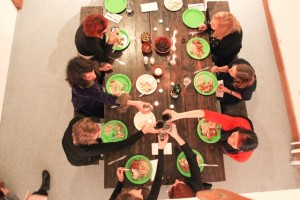Image: Sarah Rudinoff, Fiia McGann, Barbara Dollarhide Pritchard, Rhonda Pelikan, Laura Weller Vanderpoole, Kim Virant Sheryl Wiser, Molly Lannon Kenny, Gretta Harley Jess Van Nostrand in discussion at The Project Room as part of These Streets. Photograph by Sarah Jenks.
The recession of 1971 that brought the Boeing Bust was humorously commented on with a famous billboard posted at S 167th Street and Pacific Highway S near Sea-Tac International Airport that read “Will the last person leaving SEATTLE — Turn out the lights.” That self-deprecating humor still prevailed in 1989 when the young musicians who grew up 1970s Seattle now played with and to each other in small clubs. Young musicians from other parts of the country started moving to Seattle in the late 80s and early 90s adding their energy to Seattle music scene. As the band numbers grew, more clubs opened, indie record labels started. The post punk DIY ethics propelled musicians on regional tours. Musicians glue pasted hand made posters to telephone polls to advertise their shows. Local artists silkscreened T-Shirts. Small indie zines reviewed records and interviewed bands. A small living was eeked out by some, and others subsidized their passion with music through odd jobs. There was a scene here. A quiet, supportive, DIY scene.
In 1989 Seattle was largely thought of a sleepy, blue collar town. Microsoft hadn’t reached a billion dollar corporation yet, Amazon wasn’t an entity and Starbucks had not launched nationally. There was no internet. There were no cell phones. Seattle was an affordable place to live, and young people could share a rented house- paying minimal rent- with a basement to practice music in.
In 1991 the lights of the world were turned up in Seattle with the popularization of “grunge” music. The lives of the young people who were part of a small, supportive music community were forever changed. Many stories have been told, books written, films made, retrospectives celebrated, but mostly absent are the abundant women that owned labels, booking agencies, management companies and of course, led rock bands. Women toured, recorded, played live, and rocked.
Rudinoff and Harley have been interviewing musicians and gathering stories since mid 2011. They are using these real-life stories as the foundation of the play that tells of five musicians who share a house from 1989-1994. The characters are amalgams, but what is real are the stories, the flavor and the music.
The aspects to THESE STREETS are:
• a theatrical /rock music show that will premier at ACT’s historic Allen Theatre in February/March 2013
• a historical archiving of women in the Seattle rock scene- in the late 80s/early 90s- who led bands, toured, recorded, started record labels…rocked, thus adding women to the historic legacy
• a retrospective visual art show of women musicians in the late 80s/early 90s in Seattle
• an educational project aimed at adding music written by women to the standard rock repertoire taught to kids

